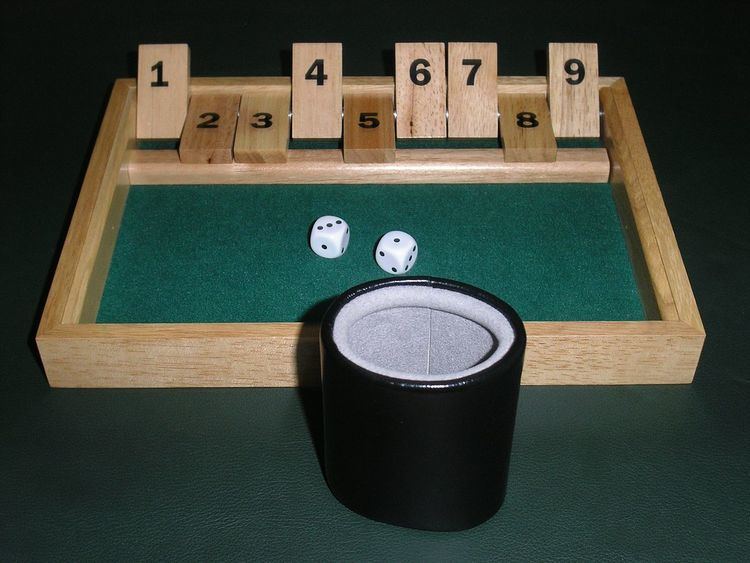Players 1 (Solitaire) or more Setup time 1 minute Random chance High (Dice rolling) | Age range 6 and up Playing time | |
 | ||
Genre(s) Dice-rolling, Solitaire | ||
Shut the Box, also called Canoga, Klackers, Batten Down the Hatches, kingoball and Jackpot, is a game of dice for one or more players, commonly played in a group of two to four for stakes. Traditionally, a counting box is used with tiles numbered 1 to 9 where each can be covered with a hinged or sliding mechanism, though the game can be played with only a pair of dice, pen, and paper. Variations exist where the box has up to 10 or 12 tiles.
Contents
Rules
At the start of the game all levers or tiles are "open" (cleared, up), showing the numerals 1 to 9.
During the game, each player plays in turn. A player begins his or her turn by throwing or rolling the die or dice into the box. If 1 is the only tile still open, the player may roll only one die. Otherwise, the player must roll both dice.
After throwing, the player adds up the pips (dots) on the dice and then "shuts" (closes, covers) one of any combination of open numbers that equals the total number of dots showing on the dice. For example, if the total number of dots is 8, the player may choose any of the following sets of numbers (as long as all of the numbers in the set are available to be covered):
The player then rolls the dice again, aiming to shut more numbers. The player continues throwing the dice and shutting numbers until reaching a point at which, given the results produced by the dice, the player cannot shut any more numbers. At that point, the player scores the sum of the numbers that are still uncovered. For example, if the numbers 2, 3, and 5 are still open when the player throws a one, the player's score is 10 (2 + 3 + 5 = 10). Play then passes to the next player.
For further clarification, if 2, 3, and 5 are the only numbers open, and the player throws a 4, their turn ends, since 4 requires either 4 or the pair 1, 3 to be open. With 2, 3, and 5 being the only open numbers, the only throws that would not end the player's turn are 2, 3, 5, 7, 8, and 10.
After every player has taken a turn, the player with the lowest score wins.
If a player succeeds in closing all of the numbers, he or she is said to have "Shut the Box" – the player wins immediately and the game is over.
Traditional pub play
In English pubs, Shut the Box is traditionally played as a gambling game. Each player deposits an agreed amount of money into a pool at the beginning of the game, and the winner of the game collects the money in pool at the end of the game.
Variants
Shut the box is a traditional game, and there are many local and traditional variations in the rules. In addition, due to the game's growing popularity, many variations of the game have developed in recent years.
The two most popular variants are:
The following are examples of known variations in play, setup, and scoring:
It is also possible to play extended versions in which each game is a "round" of a longer game. Examples of such versions include:
History
Unconfirmed histories of the game suggest a variety of origins, including 12th century Normandy (northern France) as well as the mid 20th century Channel Islands (Jersey and Guernsey) thanks to a man known as Mr. 'Chalky' Towbridge.
There is printed evidence of a dice game known as "shut the box" being played in Manchester pubs in the mid-1960s.
Shut the Box is also the basis of the popular TV quiz show High Rollers, which ran from 1974 to 1976 and 1978 to 1980 on NBC with Alex Trebek as the host. The show resurfaced from 1987 to 1988, this time hosted by Wink Martindale.
Versions have also been played in Barotseland (Zambia, central Africa). The game is also popular in the beer bars of Thailand using special rules.
